What ever happened to our green consciences? In 2009, after campaigning from green lobbyists (even then London mayor Ken Livingston chimed in calling for a boycott), annual bottled water sales dropped by 9%.
Now, it seems, all is forgotten. We’ve glugged our way through 121 million litres (8.7%) more bottled water this year than in the same period in 2012, and paid 10.6% more for the privilege. Such growth means bottled water has usurped sports & energy drinks as the fastest-growing soft drinks subcategory.
Sports & energy drinks are still growing at a respectable 6.1%, on volumes up 4.2%, but that’s where the good news in soft drinks, at a category level at least, ends. All other sectors - carbonates, squashes & cordials and juice drinks & smoothies - are in volume decline.
The hot summer of 2013 goes some way to explaining why bottled water is outshining the rest of the category. “When the temperature reaches 28C, water grows faster than any other soft drinks category,” says Silika Shellie, Nestlé Waters’ retail channel & category controller. “The heatwave drove penetration, and consumers are remaining in the category even as the weather has cooled.”
Read The Grocer’s full Top Products Survey.
Clearly the success of water can’t all be explained by the weather, however. Sales grew strongly last year, too - the wettest on record - suggesting attitudes to bottled water are changing. “A lot of consumers are switching to bottled water because it is inexpensive and all they’re really looking for is hydration,” says David Milligan, head of trading & marketing at the buying group Sugro.
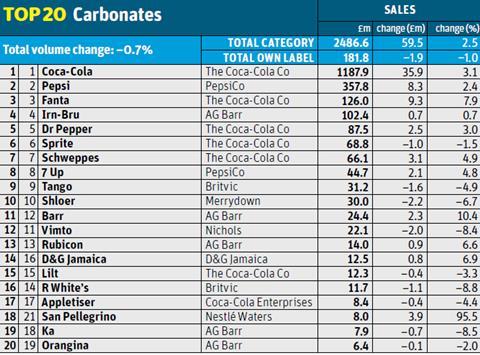
Health is also an increasingly important consideration for shoppers, says Shellie: “Consumers are starting to see the benefits of bottled water. This is particularly prevalent in families with children, as schools are helping to drive the education of being healthily hydrated throughout the day.”
Although not explicitly marketed at kids, Danone Water’s Volvic Juiced and Evian Touch of Fruit variants are certainly striking the right chord with someone: Danone says more than half its growth has come from fruit and juice variants.
San Pellegrino, which has also done well in carbonates with its fruit drinks, was the biggest grower in percentage terms - up 24.5% in value and 23.1% in volume. It also fetches an average of £1.16 a litre, up 1.1% year on year, more than double the overall average of 51p.
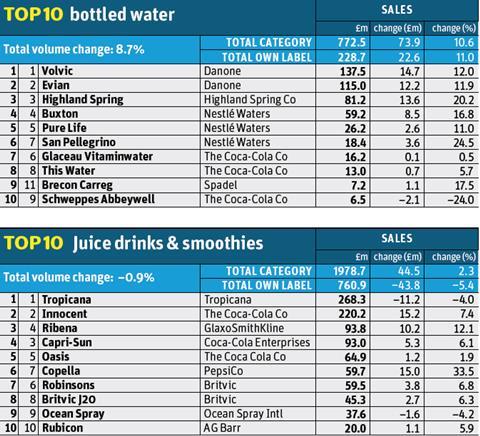
The only top 10 brand in decline is Schweppes Abbey Well, whose 500ml format was delisted by Tesco in August, while Britvic retired its Drench and Pennine Spring brands in the summer to make way for the launch of Irish water brand Ballygowan next year.
The rise of bottled water has made life tough for traditional fizzy drinks. A £2.5bn market, value sales of carbonates have risen 2.5% but volumes were down 0.7%. Coca-Cola clawed back some of the share it lost to Pepsi in 2012 - growing in value by 3.1% (or £36m) on volumes up 1.5%, against Pepsi’s growth of 2.4% on volumes down 1.2% - through a combination of increased deals, format innovation and heavyweight marketing (particularly its high-profile and hugely successful Share A Coke campaign).

Exotic flavours continue to grow in popularity and established brands are starting to cash in. This year, Fanta made 2012’s limited-edition flavour mango & passion fruit a permanent addition to the range (though this hasn’t been enough to put the number three brand in volume growth), and Ribena launched mango & lime and pineapple & passion fruit variants (likewise, in squashes Ribena is still in volume decline).
“Following the success AG Barr has had with Rubicon, exotic flavours go from strength to strength,” says Milligan. “Ribena’s mango & lime flavour was one of the best new soft drinks this year.”
Over in sports & energy drinks, however, healthy top-line growth hides a growing crisis for traditional sports drink brands. Powerade sales fell 29.2% and Gatorade sales plunged 49.1% making a 3.5% drop in Lucozade Sport sales look like a good result. The fact that the brand has been claiming it ‘hydrates better than water’ in its marketing this year speaks volumes about who sports drinks are losing their business to.
Shoppers are also switching to perceived healthier alternatives, such as coconut water. Vita Coco enjoyed a 128.8% increase in sales to £10.9m. “Consumers are beginning to realise that for gym sessions and exercise under one hour, the sugars and carbohydrates found in many sports drinks are not required,” says Vita Coco’s UK brand manager Hugh Thomas. “Alternatives like coconut water and water are more healthy replacements.”
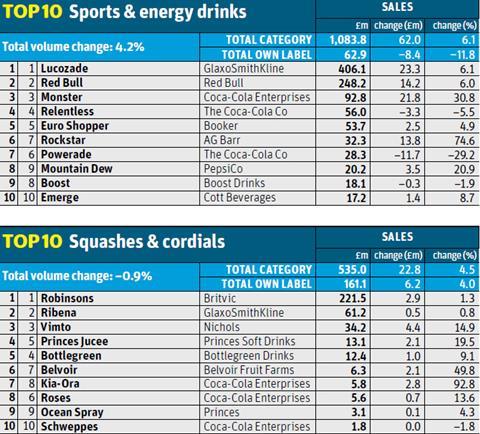
Sports drinks suppliers can at least take solace from continued success with energy drink brands. Despite being the biggest brand in the market, Lucozade Energy still clocked up growth of 8% this year, and sales of CCE’s Monster energy brand grew by a third. New flavours are helping to grow the energy drink market. Recent examples include Red Bull’s new Editions range and Monster’s new green tea and orangeade variants.
Not everyone in energy is having it all their own way, however. CCE’s Relentless brand’s 4.4% decline in average price to £2.56 a litre suggests it’s been forced to promote hard to compete with high-growth budget brands such as Emerge and Euroshopper, which sell for £1.25 and £1.24 a litre respectively. To no avail: Relentless lost 5.5% of its value sales, on volumes down 1.2%.
Red Bull and Monster’s average price has also fallen as they’ve looked to stand up to cut-price rivals. Red Bull - one of the most expensive brands at an average of £4.73 a litre - has been running two-for-£2 deals on 250ml cans to remain competitive in the past year, contributing to a 3% decline in average price.
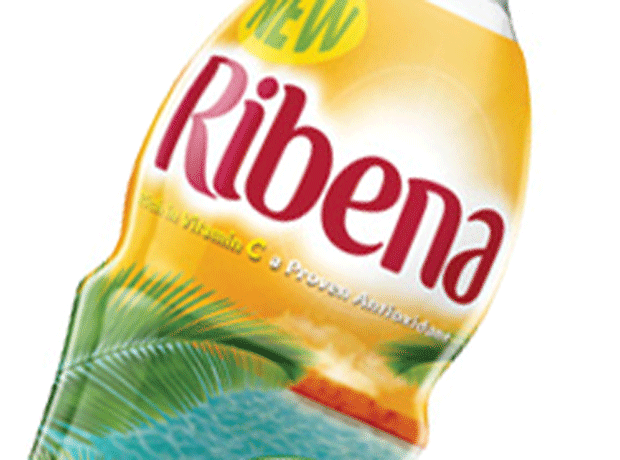
While price is still important over in juices and smoothies, the battle between Tropicana and Innocent took on a new dimension in 2013. After recording a 24.8% decline last year, Tropicana introduced new low-calorie juice drink Trop 50. Sold at an average of £1.61 a litre (compared with Innocent’s £2.16 and Tropicana’s £1.96), the brand has racked up £12.7m since its January launch, but it was not enough to stop Tropicana’s sales from falling again (albeit at a slower rate). However, the £11.2m loss was more than offset by sibling Copella’s £15m in extra sales.
In the meantime, value sales of Innocent’s smoothies and juices are up a further 7.4% volumes are up 10.5%. “This year, we’ve seen a strong performance in not-from-concentrate juice. Within that, our juice blends range, our apple juice and our larger pack formats have all done well,” says a spokeswoman. Three new juice blends, additional distribution and a focus on deals, contributing to a slight dip in average price, all helped.
The only headache for juice brands has been commodity cost inflation. While a lot of commodity prices have come down this year, fruit is an exception. “We have seen overall fruit price inflation as a result of increased global demand and examples of poor availability due, in the main, to weather impacts,” says the Innocent spokeswoman.
Over in squashes & cordials, the top two brands are having a harder time competing with lower-priced challenger brands (and own label). Helped by a packaging revamp in the spring, Princes Juicee, for example, enjoyed growth of 19.5% as the brand’s average price stayed constant at 58p a litre compared with the subcategory average, which climbed 5.3% to £1.19 a litre.
Having handed over to GSK an eyewatering £1.35bn this autumn, one question for 2014 is what Suntory will do with Ribena and Lucozade. The other question is over the weather. In a World Cup year, another scorcher wouldn’t go amiss.
Read The Grocer’s full Top Products Survey.
Top launch: Trop 50 Tropicana
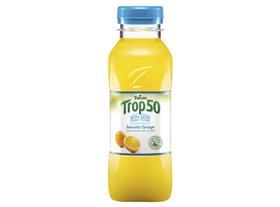
The high sugar content of juices and smoothies has been the subject of many a newspaper exposé this year. With half the calories and sugar of regular juice, Trop 50 is therefore a timely addition to Tropicana’s range. It contains a mixture of not-from-concentrate juice and water, plus the natural sweetener stevia. Since launching in January, it has notched up £15m in sales. Still, it has some way to go before it replicates its success in the US where it launched in 2009 and is now a $200m range.







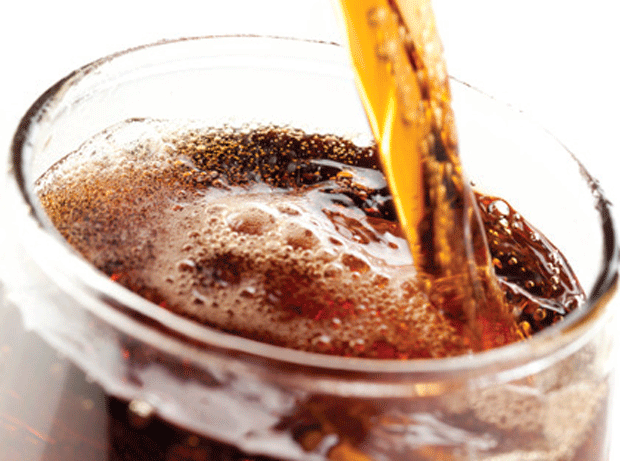
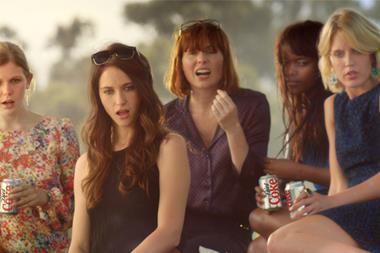
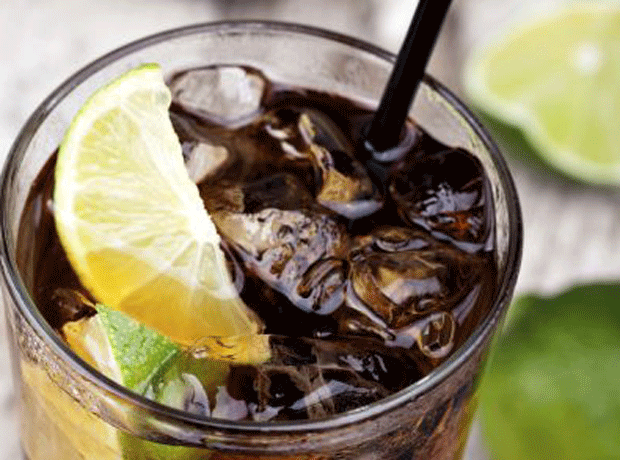


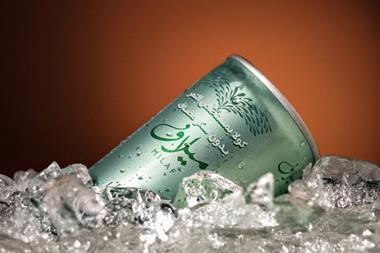






No comments yet